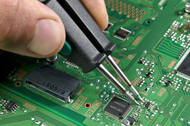Guide to Safe Handling of PCB Repair Work
Sep 8th 2022
The majority of electrical gadgets are built around printed circuit boards. A printed circuit board, or PCB for short, is an electronic board containing embedded metal circuits that link various parts of the apparatus. It comprises layers that are first individually etched, then laminated to create patterns called traces. These patterns represent the paths taken by signals as they move around the circuit board and transfer data between various components.
The truth is that no soldering procedure consistently results in producing flawless assemblies. Even the greatest grade parts can malfunction. For people who create, maintain, or repair printed circuit boards, opting for intensive PCB repair training for making the finest rework and repair techniques and materials (PCBs) is crucial.
How should PCBs be handled safely when being repaired?
Printed circuit boards (PCBs) must be handled carefully to avoid causing more harm than you can fix. Concerning problems include the following:
Wear safety glasses: Safety glasses should always be used when repairing a PCB since the solder can splatter and leads can fly when cut.
Unplug and discharge your electronics: Ensure the equipment you are repairing is unplugged and completely removed to avoid short-circuiting the electronics and perhaps electrocuting yourself.
Pay close attention to ensure that capacitors and power supplies are completely discharged because they can store a charge. Disconnect any additional batteries if there are any.
Prevent static discharge: Elect electrostatic discharge, or ESD, is a spark or sudden movement of electrons from one surface to another. One surface has more electrons than the other due to a difference between the two surfaces. Since nature prefers balance, dispersion is made more even by exchanging electrons.
The best way to avoid ESD is to wear a grounded wrist strap and work on a grounded ESD-safe mat. A wrist strap can leak extra electrons because it has a conductive surface that comes in contact with the skin. An ESD-safe mat operates on a similar tenet and dissipates a charge from anything that touches its surface. Using a PC, you may clip the wrist strap on the case's unpainted surface.
Wash your hands before handling anything and only handle the PCBs edges to prevent contamination: Your hands' contamination could cause solderability problems and may result in board failure due to corrosion or dendritic growth. Silicone from hand lotion or other sources can form a barrier on the soldering surface that could inhibit the solder from developing a strong metallurgical link. When subjected to thermal or physical stress, the solder may first momentarily adhere before popping off.
Another significant factor contributing to issues throughout the mending process is contamination, such as salt from the fries you had with lunch. When mixed with moisture from the air, salt, an ionic soil, can lead to corrosion.
Dendrites form when the ionic particles might result in current leakage and potentially short-circuiting. A smart approach to avoid this kind of board failure is to wash your hands frequently and only use hand lotion that is safe for electronic devices. Additionally, using only the board's edges to hold it without making any touches (such as with gold fingers) can prevent contaminant deposits on any important regions.

